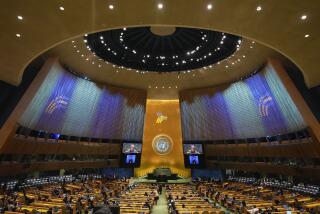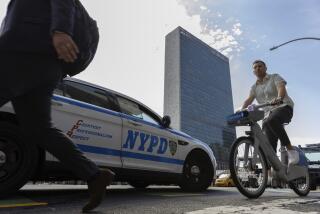Spirit of Good Feeling Marks Summit’s End
- Share via
GENEVA — With huge Soviet and American flags draped behind them on the back wall, President Reagan and Soviet leader Mikhail S. Gorbachev chatted and gestured. They brimmed with confidence and a show of optimism Thursday as they watched top aides sign a series of minor agreements in the ceremony closing their summit in Geneva.
Both leaders insisted that their three days of conversation should be counted a success--not for reaching any accord on the deep and dangerous divisions between the superpowers, but for creating a spirit of good feeling that might help them deal with those divisions sometime in the future.
With almost every public smile and remark before leaving Geneva, they tried hard to prove that the mood was real.
Red, White and Blue Tie
For their final joint appearance, Gorbachev even wore a tie with small but unmistakable red, white and blue stripes.
The theme Gorbachev struck--that “the world has become a safer place”--dominated the final day of the summit, whether it bore any relation to reality or not.
For the closing ceremony, Reagan and Gorbachev each sat on a green-striped, upholstered armchair, their interpreters behind them, on a stage in the tightly guarded International Conference Center that has served as headquarters for the 3,000 journalists covering the summit.
Reagan sat cross-legged, Gorbachev with his legs uncrossed, as they bantered back and forth.
Outside, heavily armed Swiss troops surrounded the arena as the already tight security became even tighter. Cars belonging to residents of the area were towed away during the night to protect against any terrorist activity.
If security was extreme, so was the sense of anticipation, enhanced by the total news blackout that kept the world in the dark during the meetings themselves.
The tension was not relieved by a joint statement, already delivered to the press, that had announced that the two men intended to meet again, first in the United States, then in the Soviet Union. No dates were set.
After Swiss President Kurt Furgler congratulated them, Gorbachev walked to a lectern and took out some folded sheets of paper from the inside of his blue pin-striped suit, put on his glasses, unfolded the papers and read from them.
Gorbachev said: “The President and I have done a huge amount of work. We’ve gone into great detail. We’ve really done it in depth. And we’ve done it totally openly and frankly.”
Gorbachev acknowledged that “we didn’t succeed in reaching at this meeting the solving of the most important problems concerning the arms race and increasing hopes of peace.”
Nevertheless, he said, he and Reagan had agreed to continue arms control negotiations in Geneva and to seek new ways of developing relations between the two countries. When he completed his statement, he looked pleased and a trace of a smile appeared on his lips as he walked back to his seat.
Reagan Next to Speak
Reagan then arose and took Gorbachev’s place at the lectern. He wore a solid blue suit. His tie was patterned but not striped in red, white and blue. He, too, read from a paper.
“We’ve packed a lot into the last two days,” the President said. “. . . I’m convinced that we are heading in the right direction.
“The real report card on Geneva will not come in for months or even years,” he went on. “But we know the questions that must be answered. . . . I leave Geneva today and our fireside summit determined to pursue every opportunity to build a safer world of peace and freedom.”
Smiling even more, Reagan, too, looked satisfied as he returned to the chair next to Gorbachev. His reference to a “fireside summit” alluded to the several private sessions the two leaders held in rooms with blazing fireplaces on the cold, gray, snow-flurried days of their summit.
Since the accords were too minor to merit the signatures of Reagan and Gorbachev, Secretary of State George P. Shultz and Soviet Foreign Minister Eduard A. Shevardnadze stepped onto the stage to sit at a table and sign the documents.
Toast Closes Conference
While they did so, Reagan and Gorbachev stood behind, whispering, smiling, gesturing. After the documents were signed, the leaders and their top aides shook hands all around, then retreated to another room where the two leaders spent another 13 minutes alone. Afterwards, they invited their aides in for a champagne toast. The time was 10:39 a.m. in Geneva, and the summit conference came to a close.
But another major event followed. Gorbachev returned to the Soviet Mission compound for a press conference, a rare event for a leader of the Soviet Union. Flanked by Kremlin aides, Gorbachev, looking at notes occasionally, presented his views of the summit in an hourlong monologue, followed by 40 minutes of questions. He spoke softly, gesturing often, sometimes cutting at his table with the side of his open hand.
After 20 minutes or so, he apologized for speaking so long with so many generalities. “I am trying to have less cotton wool in my speech,” he said, “but I know you need a bit of it.”
Gorbachev acknowledged again that he and the President had failed to reach any understanding on the future of Reagan’s “Star Wars” program. Their discussion, the Soviet leader said, had become “very lively indeed.” While the President continued to describe his program as a defensive shield, Gorbachev continued to describe it as a potential space weapon that could destabilize the whole system of nuclear balance.
Yet Gorbachev still praised his sessions with Reagan as a way for the two to understand each other.
“You need truth like you need air to breathe,” he said. “. . . What could be better than direct talks? There’s no more hiding from truth when you are face to face.”
After his statement, there was only time for a few questions. In reply to one asking him to assess the results of the summit, Gorbachev said, “I can leave this hospitable city of Geneva looking toward the future optimistically.”
More to Read
Sign up for Essential California
The most important California stories and recommendations in your inbox every morning.
You may occasionally receive promotional content from the Los Angeles Times.













